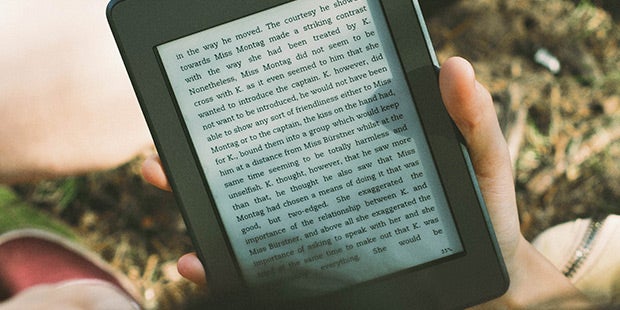Recent reports suggest that eBook growth has plateaued and millennials haven’t been adopting digital reading at the same rate as their parents. Are eBooks still the future?
We sat down with Liisa McCloy-Kelley, Vice President, Director, eBook Development and Innovation, to learn more about the eBook landscape and how the format is developing.
Liisa, how has the eBook landscape changed over the last year or so?
 The eBook market has matured over the last couple of years, with sales growing more slowly. Fewer new devices have launched recently, and this has impacted growth, as many heavy readers have already adopted devices and platforms. For example, last holiday season saw no big new device in the market, which meant that we didn’t see the uptick in sales we would have seen a couple of years ago. On top of that, eBooks’ share of total sales in adult fiction, adult nonfiction, and juvenile titles is flattening out to a more steady state with a good mix of physical and digital sales. We’ve watched rapid shifts of digital adoption in other media industries (music, video, TV, magazines, and newspapers), where overall sales have dropped as digital has risen, and physical has been left to the wayside. But books have evolved differently. The total sales of books across formats have been steady and the desire for the print experience and the gift value of a physical book endures.
The eBook market has matured over the last couple of years, with sales growing more slowly. Fewer new devices have launched recently, and this has impacted growth, as many heavy readers have already adopted devices and platforms. For example, last holiday season saw no big new device in the market, which meant that we didn’t see the uptick in sales we would have seen a couple of years ago. On top of that, eBooks’ share of total sales in adult fiction, adult nonfiction, and juvenile titles is flattening out to a more steady state with a good mix of physical and digital sales. We’ve watched rapid shifts of digital adoption in other media industries (music, video, TV, magazines, and newspapers), where overall sales have dropped as digital has risen, and physical has been left to the wayside. But books have evolved differently. The total sales of books across formats have been steady and the desire for the print experience and the gift value of a physical book endures.
Fiction has always been popular in electronic formats because so many heavy readers of fiction traditionally consume three or four mass-market books a week in categories like Romance, Mystery, and Science Fiction. These readers made the shift early, because eBooks made books instantly available and easy to buy.
Interestingly, over the past year, Body & Mind and History—two categories not known for their digital success—have enjoyed nice upward trends. This has been accompanied by improvements in the eBook reading experience—higher-quality images and charts, slide shows, and better handling of footnotes—so we are optimistic that growth will continue.
Is growth in digital being driven by younger readers?
The initial growth wave in eBooks was driven by an older demographic, the typical genre-fiction reader who valued the convenient access and the immersive experience, as well as the ability to read at a larger font size. We are definitely looking to younger readers to see how trends will continue. We class those born between 1980 and 1999 as “millennials,” and that demographic has some pretty interesting attitudes about technology.
Despite being very technology-driven in their consumption of news media, a large proportion of millennials seem loyal to print in their reading. Perhaps it’s a backlash against the steep rise of digital reading, or perhaps they don’t have the early digital reading habits that someone born more recently will have had. We still see high print share for children’s books these days, so it will be interesting to what degree reading habits will change as the digital natives age.
What is EPUB 3 and why does it matter to authors?
EPUB 3 is a relatively new industry standard that is being adopted worldwide for eBooks. Adoption has been gradual because it required a number of major technological advances for both the sellers and creators of content. EPUB 3 will benefit authors because it will help book content be reliably displayed across all devices. It won’t be completely consistent because each platform has its own back-end issues, but it should be a big improvement.
Two immediate impacts will be an increased ability to style books and support multiple languages. Books can paginate front-to-back or back-to-front. Reading can go up-down, left-right, any direction that a language requires. This has been a major help in the adoption of eBook standards and market growth in Asia. EPUB 3 also makes content more accessible to the print-disabled. And finally, it is the beginning of support for more interactivity in books. This is the piece that has developed the slowest, but that holds the greatest promise for where EPUB 3 can take us.
How do you decide what kind of layout is best for a particular book?
In many respects the layout is decided by genre. Most fiction and straight-text nonfiction, for example, is best represented as a reflowable book. Books with artwork where the aspect ratio must be preserved display best as a “print replica fixed page.” This often includes children’s picture books, comics, manga, and graphic novels. It’s all about finding what layout fits the storytelling of a particular book.
We also find there are areas where it’s not readily apparent what will create the best reading experience. Cooking and Crafts are two such areas, and we often redesign the book in order to take advantage of the screen space we have, resulting in less white space and bigger fonts. We are also introducing more interactive elements so the reader isn’t overwhelmed by trying to read an oversized coffee-table book crammed onto a small screen.
What are the most successful enhancements to eBooks?
The most successful enhancements to books are ones that mirror changes in reading trends. For example, we’ve seen a huge increase in reading on phones. When you see people on the street or standing in line at the store, not everyone is looking at their email and text messages—some are also reading books in bite-sized chunks. Therefore adding short, bite-sized chunks of video to an eBook is more successful than adding one twenty-minute video at the end. When you have a really immersive story, screen size doesn’t matter.
The substance of the content is also important. The most successful enhanced content provides insight into the characters, the storytelling, or the author’s inspiration and process that readers might not have had otherwise.
What types of enhancements will we see in eBooks in the future?
I think we will see more exciting moments of interactivity that make sense for the title. This might include better use of charts and graphs, or better ways to download a pattern from a craft book. If an author creates a family tree, we might find opportunities to integrate it throughout the book for reference.
In addition, there will be innovations to the way we navigate books and explore stories that don’t necessarily mirror what we’ve done in print. This has the potential to introduce new kinds of stories, but also to provide a second, digital life to books in order to make their stories more readily accessible on screens.
What can authors do to make sure their eBooks are as effective as possible?
It’s really beneficial for an author to think about extra content they might want in their eBook while they are writing. Because we are less limited by page count, the eBook is always an opportunity to add more content. If ever you reach a point in your process where you are holding back or cutting material due to size constraints in print, talk to your editor about whether this material could be included in a digital version.
Strong content includes author’s notes, photographs or other images, reading group guides, and class discussion questions.
You may also want to talk to your editor about new ways information might be displayed in a digital version. Charts don’t always have to be charts, and graphs don’t always have to be displayed on the same axis. If the eBook is part of your editorial conversation during the writing and publishing process, we can come up with really exciting ways to enhance the reading experience.
Emily Condlin works in the legal department and on cross-departmental corporate projects at Penguin Random House.


